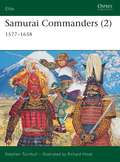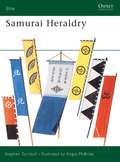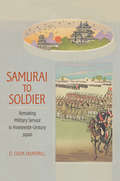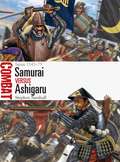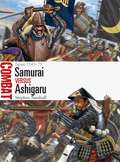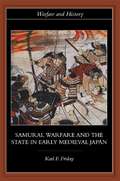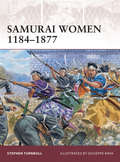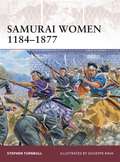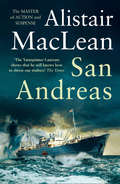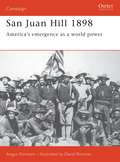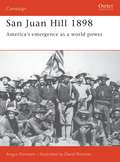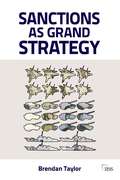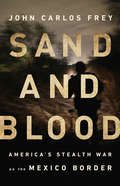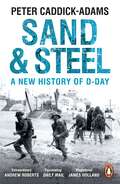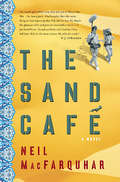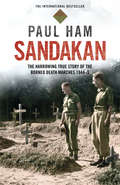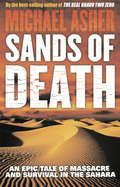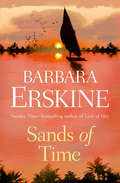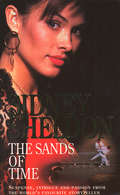- Table View
- List View
Samurai Commanders: 1577–1638 (Elite #128)
by Stephen Turnbull Richard HookThis second volume about Japan's samurai commanders covers the generals of the later years of the Age of the Warring States, a period when only the most able leaders survived. This was a time when the prowess of a commander was measured as much by his strategic and organizational abilities as by his individual fighting skills and he was expected to give as great a show of strength in the council chamber as on the battlefield. This book discusses the lives, battles and wider roles of talented commanders such as Oda Nobunaga and Toyotomi Hideyoshi great men who stood out prominently due to their elaborate suits of armour and helmets, their stunning personal heraldry and their great armies.
Samurai Heraldry (Elite)
by Stephen Turnbull Angus McBrideThe dazzling spectacle presented by the armies of medieval Japan owed much to the highly developed family and personal heraldry of samurai society. From simple personal banners, this evolved over centuries of warfare into a complex system of flags worn or carried into battle, together with the striking 'great standards' of leading warlords. While not regulated in the Western sense, Japanese heraldry developed as a series of widely followed practices, while remaining flexible enough to embrace constant innovation. Scores of examples, in monochrome and full colour, illustrate this fascinating explanation of the subject by a respected expert on all aspects of samurai culture.
Samurai Heraldry (Elite #82)
by Stephen Turnbull Angus McBrideThe dazzling spectacle presented by the armies of medieval Japan owed much to the highly developed family and personal heraldry of samurai society. From simple personal banners, this evolved over centuries of warfare into a complex system of flags worn or carried into battle, together with the striking 'great standards' of leading warlords. While not regulated in the Western sense, Japanese heraldry developed as a series of widely followed practices, while remaining flexible enough to embrace constant innovation. Scores of examples, in monochrome and full colour, illustrate this fascinating explanation of the subject by a respected expert on all aspects of samurai culture.
Samurai to Soldier: Remaking Military Service in Nineteenth-Century Japan (Studies of the Weatherhead East Asian Institute, Columbia University)
by D. Colin JaundrillIn Samurai to Soldier, D. Colin Jaundrill rewrites the military history of nineteenth-century Japan. In fifty years spanning the collapse of the Tokugawa shogunate and the rise of the Meiji nation-state, conscripts supplanted warriors as Japan’s principal arms-bearers. The most common version of this story suggests that the Meiji institution of compulsory military service was the foundation of Japan’s efforts to save itself from the imperial ambitions of the West and set the country on the path to great power status. Jaundrill argues, to the contrary, that the conscript army of the Meiji period was the culmination—and not the beginning—of a long process of experimentation with military organization and technology. Jaundrill traces the radical changes to Japanese military institutions, as well as the on-field consequences of military reforms in his accounts of the Boshin War (1868–1869) and the Satsuma Rebellions of 1877. He shows how pre-1868 developments laid the foundations for the army that would secure Japan’s Asian empire.
Samurai vs Ashigaru: Japan 1543–75 (Combat)
by Stephen TurnbullDuring the 16th century, Japan underwent a military revolution, characterized by the deployment of large armies, the introduction of firearms and an eventual shift towards fighting on foot. This study encapsulates these great changes through an exploration of the experience on the ground at three key battles, Uedahara (1548), Mikata ga Hara (1573) and Nagashino (1575), in which two very different types of warrior were pitted against each other. On one side were samurai, the elite aristocratic knights whose status was proclaimed by the possession and use of a horse. On the other side were the foot soldiers known as ashigaru, lower-class warriors who were initially attendants to the samurai but who joined the armies in increasing numbers, attracted by loot and glory. These two types of warrior battled for dominance across the period, changing and adapting their tactics as time went on. In this title, the development of the conflicts between samurai and ashigaru is explored across three key battles, where highly trained elite mounted samurai of the Takeda clan faced ashigaru at very different stages in their development. The profound and irreversible changes that took place as the conflicts progressed are analysed in detail, culminating in the eventual incorporation of the ashigaru as the lowest ranks of the samurai class in within the standing army of Tokugawa Japan.
Samurai vs Ashigaru: Japan 1543–75 (Combat)
by Stephen TurnbullDuring the 16th century, Japan underwent a military revolution, characterized by the deployment of large armies, the introduction of firearms and an eventual shift towards fighting on foot. This study encapsulates these great changes through an exploration of the experience on the ground at three key battles, Uedahara (1548), Mikata ga Hara (1573) and Nagashino (1575), in which two very different types of warrior were pitted against each other. On one side were samurai, the elite aristocratic knights whose status was proclaimed by the possession and use of a horse. On the other side were the foot soldiers known as ashigaru, lower-class warriors who were initially attendants to the samurai but who joined the armies in increasing numbers, attracted by loot and glory. These two types of warrior battled for dominance across the period, changing and adapting their tactics as time went on. In this title, the development of the conflicts between samurai and ashigaru is explored across three key battles, where highly trained elite mounted samurai of the Takeda clan faced ashigaru at very different stages in their development. The profound and irreversible changes that took place as the conflicts progressed are analysed in detail, culminating in the eventual incorporation of the ashigaru as the lowest ranks of the samurai class in within the standing army of Tokugawa Japan.
Samurai, Warfare and the State in Early Medieval Japan (Warfare and History)
by Karl F. FridayKarl Friday, an internationally recognised authority on Japanese warriors, provides the first comprehensive study of the topic to be published in English. This work incorporates nearly twenty years of on-going research and draws on both new readings of primary sources and the most recent secondary scholarship. It overturns many of the stereotypes that have dominated views of the period. Friday analyzes Heian -, Kamakura- and Nambokucho-period warfare from five thematic angles. He examines the principles that justified armed conflict, the mechanisms used to raise and deploy armed forces, the weapons available to early medieval warriors, the means by which they obtained them, and the techniques and customs of battle.A thorough, accessible and informative review, this study highlights the complex casual relationships among the structures and sources of early medieval political power, technology, and the conduct of war.
Samurai, Warfare and the State in Early Medieval Japan (Warfare and History)
by Karl F. FridayKarl Friday, an internationally recognised authority on Japanese warriors, provides the first comprehensive study of the topic to be published in English. This work incorporates nearly twenty years of on-going research and draws on both new readings of primary sources and the most recent secondary scholarship. It overturns many of the stereotypes that have dominated views of the period. Friday analyzes Heian -, Kamakura- and Nambokucho-period warfare from five thematic angles. He examines the principles that justified armed conflict, the mechanisms used to raise and deploy armed forces, the weapons available to early medieval warriors, the means by which they obtained them, and the techniques and customs of battle.A thorough, accessible and informative review, this study highlights the complex casual relationships among the structures and sources of early medieval political power, technology, and the conduct of war.
Samurai Women 1184–1877 (Warrior #151)
by Giuseppe Rava Dr Stephen TurnbullFrom when the Empress Jingo-kogo led an invasion of Korea while pregnant with the future Emperor Ojin, tales of female Japanese warriors have emerged from Japan's rich history. Using material that has never been translated into English before, this book presents the story of Japan's female warriors for the first time, revealing the role of the women of the samurai class in all their many manifestations, investigating their weapons, equipment, roles, training and belief systems. Crucially, as well as describing the women who were warriors in their own right, like Hauri Tsuruhime and the women of Aizu, this book also looks at occasions when women became the power behind the throne, ruling and warring through the men around them.
Samurai Women 1184–1877 (Warrior)
by Stephen Turnbull Giuseppe RavaFrom when the Empress Jingo-kogo led an invasion of Korea while pregnant with the future Emperor Ojin, tales of female Japanese warriors have emerged from Japan's rich history. Using material that has never been translated into English before, this book presents the story of Japan's female warriors for the first time, revealing the role of the women of the samurai class in all their many manifestations, investigating their weapons, equipment, roles, training and belief systems. Crucially, as well as describing the women who were warriors in their own right, like Hauri Tsuruhime and the women of Aizu, this book also looks at occasions when women became the power behind the throne, ruling and warring through the men around them.
San Andreas: San Andreas, The Golden Rendezvous, Seawitch, Santorini
by Alistair MacLeanAnother magnificent tale of treachery at sea from a storytelling genius.
San Juan Hill 1898: America's Emergence as a World Power (Campaign)
by Angus Konstam David RickmanLabelled a 'splendid little war' by Senator John Hay, the Spanish American War was a peculiar event in America's history, provoked as much by the press as by political pressures. Here, aided by superbly detailed maps and artwork, the author deals with the clashes at Las Guasimas and El Caney, the capture of San Juan Hill, and the naval battle and siege of Santiago. The war was to mark the end of Spanish sovereignty in her 'New World', and the establishment of the United States of America as a world power.
San Juan Hill 1898: America's Emergence as a World Power (Campaign #57)
by Angus Konstam David RickmanLabelled a 'splendid little war' by Senator John Hay, the Spanish American War was a peculiar event in America's history, provoked as much by the press as by political pressures. Here, aided by superbly detailed maps and artwork, the author deals with the clashes at Las Guasimas and El Caney, the capture of San Juan Hill, and the naval battle and siege of Santiago. The war was to mark the end of Spanish sovereignty in her 'New World', and the establishment of the United States of America as a world power.
Sanctions as Grand Strategy: Sanctions As Grand Strategy (Adelphi series)
by Brendan TaylorEconomic sanctions are becoming increasingly central to shaping strategic outcomes in the twenty-first century. They afford great powers a means by which to seek to influence the behaviour of states, to demonstrate international leadership and to express common values for the benefit of the international community at large. Closer to home, they can also offer a 'middle way' for governments that apply them, satisfying moderates and hardliners alike. For some great powers in the multipolar world order, however, they pose a threat to trading relationships. They may also serve as a prelude to military action. With China's international voice growing in prominence and Russia asserting its renewed strength, often in opposition to the use of sanctions, it will be ever more difficult to reach a consensus on their application. Against this backdrop, knowing what kind of measures to take and in which scenarios they are most likely to work is invaluable. This Adelphi focuses on the different sanctions strategies of the United States, China, Russia, Japan and the EU, with regard to the unfolding nuclear crises in Iran and North Korea. It examines how these measures, designed to marginalise the regimes in both countries and restrict their ability to develop nuclear weapons, have also influenced the sanctioning states' international partners. As such, they are not just a tool of statecraft: they are potentially an important facet of grand strategy.
Sanctions as Grand Strategy (Adelphi series)
by Brendan TaylorEconomic sanctions are becoming increasingly central to shaping strategic outcomes in the twenty-first century. They afford great powers a means by which to seek to influence the behaviour of states, to demonstrate international leadership and to express common values for the benefit of the international community at large. Closer to home, they can also offer a 'middle way' for governments that apply them, satisfying moderates and hardliners alike. For some great powers in the multipolar world order, however, they pose a threat to trading relationships. They may also serve as a prelude to military action. With China's international voice growing in prominence and Russia asserting its renewed strength, often in opposition to the use of sanctions, it will be ever more difficult to reach a consensus on their application. Against this backdrop, knowing what kind of measures to take and in which scenarios they are most likely to work is invaluable. This Adelphi focuses on the different sanctions strategies of the United States, China, Russia, Japan and the EU, with regard to the unfolding nuclear crises in Iran and North Korea. It examines how these measures, designed to marginalise the regimes in both countries and restrict their ability to develop nuclear weapons, have also influenced the sanctioning states' international partners. As such, they are not just a tool of statecraft: they are potentially an important facet of grand strategy.
Sanctity as literature in late medieval Britain (Manchester Medieval Literature and Culture)
by Anke Bernau E. Von ContzenThis collection explores some of the many ways in which sanctity was closely intertwined with the development of literary strategies across a range of writings in late medieval Britain. Rather than looking for clues in religious practices in order to explain such changes, or reading literature for information about sanctity, these essays consider the ways in which sanctity - as concept and as theme - allowed writers to articulate and to develop further their 'craft' in specific ways. While scholars in recent years have turned once more to questions of literary form and technique, the kinds of writings considered in this collection - writings that were immensely popular in their own time - have not attracted the same amount of attention as more secular forms. The collection as a whole offers new insights for scholars interested in form, style, poetics, literary history and aesthetics, by considering sanctity first and foremost as literature
Sand and Blood: America's Stealth War on the Mexico Border
by John Carlos FreyA damning portrait of the U.S.-Mexico border, where militaristic fantasies are unleashed, violent technologies are tested, and immigrants are targeted.Over the past three decades, U.S. immigration and border security policies have turned the southern states into conflict zones, spawned a network of immigrant detention centers, and unleashed an army of ICE agents into cities across the country.As award-winning journalist John Carlos Frey reveals in this groundbreaking book, the war against immigrants has been escalating for decades, fueled by defense contractors and lobbyists seeking profits and politicians--Republicans and Democrats alike--who relied on racist fear-mongering to turn out votes. After 9/11, while Americans' attention was trained on the Middle East and the wars in Iraq and Afghanistan, the War on Terror was ramping up on our own soil--aimed not at terrorists but at economic migrants, refugees, and families from South and Central America seeking jobs, safety, and freedom in the U.S.But we are no safer. Instead, families are being ripped apart, undocumented people are living in fear, and thousands of migrants have died in detention or crossing the border.Taking readers to the Border Patrol outposts, unmarked graves, detention centers, and halls of power, Sand and Blood is a frightening, essential story we must not ignore.
Sand and Steel: A New History of D-Day
by Peter Caddick-AdamsThe most comprehensive and authoritative history of D-Day ever published‘Extraordinary’ Andrew Roberts‘Brilliant’ Jeremy Black‘Magisterial’ James Holland________________6 June 1944, 4 a.m. Hundreds of boats assemble off the coast of Normandy. By nightfall, thousands of the men they carry will be dead.Through their sacrifice, the Allies will gain a foothold in Europe that will ultimately lead to the downfall of the Third Reich.This was D-Day, the most important day of the twentieth century.________________In Sand and Steel, one of Britain’s leading military historians draws on a decade of archival research and thousands of interviews to offer a panoramic new account of the Allied invasion of France.Peter Caddick-Adams masterfully recreates what it was like to wade out onto the carnage of Omaha Beach, facing the machine-gun fire that wiped out whole battalions of troops. He delves into how the Allied generals came to choose Normandy in June 1944, and describes the extraordinary subterfuge that went into keeping the decision secret. And he recounts how the operation transformed the lives of Britons back home, transforming sleepy villages in the Home Counties into bustling military outposts. His findings offer revelatory new insights into our understanding of D-Day. Sand and Steel is the only book to discuss the experiences of every major military force: not just the infantrymen on the beaches, but also the paratroopers, sailors and aircrew, resistance fighters in France, women on the Home Front, and even the German Wehrmacht. It offers the first full analysis of the year-long invasion preparations, revealing that more men died in training exercises than during the landing itself. Above all, it pays tribute to soldiers of all nationalities, demonstrating that the often-overlooked UK and Canadian were just as crucial to victory as the American forces were. The result is an authoritative and compulsively readable exploration of the most important battle in history. It will be the definitive work on D-Day for years to come.________________PRAISE FOR SAND AND STEEL‘Whether you are a visitor to the Normandy battlefields, a general reader interested in the greatest amphibious assault in the history of warfare, or just someone who appreciates extremely well-written military history . . . this truly extraordinary book is undoubtedly the one for you.’ Andrew Roberts‘Following his excellent study of the Battle of the Bulge, Caddick-Adams does it again by explaining, as opposed to simply describing, the Allies’ victory.’ Jeremy Black‘Peter Caddick-Adams is unquestionably one of the very finest historians of the Second World War . . . His D-Day must surely go down as the definitive narrative of that pivotal moment in the history of the war.’ James Holland
The Sand Cafe: A Novel
by Neil MacFarquharDhahran Palace Hotel, Saudi Arabia, 1991. The US forces are massing on the border with Iraq, preparing to throw Saddam Hussein out of Kuwait. Men and material are arriving daily, helicopters and armor are training in the desert sand. There are rumors of Scud missiles, talk of the possibility of chemical attack, but in fact, nothing is really happening. With no story to report, the press is getting restive. The Sand Café is a satire of modern war reporting that mercilessly exposes the life of the foreign correspondent: endless scurrying trips in pursuit of a really big story, gathering frustration, brewing jealousy directed towards other reporters, especially those from better financed TV networks, and the stale smell of damp rot that comes from a combination of leaking air-conditioning and wretched carpeting in the hotel where the entire bedraggled press corps is housed. Boredom massages idle thoughts into wild excesses, even in a country that officially bans the sale of alcohol. Neil MacFarquhar, a veteran of the Middle East foreign press corps, has written a woundingly witty black comedy of those who bring us news from the front lines, exposing their vanities, rivalries and petty distractions. Love, lust for fame and the magnificent gilded hypocrisy of the regime in Saudi make this novel as revealing as it is compelling.
Sandakan: The Untold Story Of The Sandakan Death Marches
by Paul HamAfter the fall of Singapore in 1942, the conquering Japanese Army transferred some 2500 British and Australian prisoners to a jungle camp at Sandakan, on the east coast of North Borneo. There they were beaten, broken, worked to death, thrown into bamboo cages on the slightest pretext and subjected to tortures so ingenious and hideous that the victims were driven to the brink of madness. But it was only to be the beginning of the nightmare. In late 1944 when Allied aircraft began bombing the coastal towns of Sandakan and Jesselton, the Japanese resolved to abandon the prison camp and move the prisoners 250 miles inland to Ranau. The journey there became known as the Sandakan Death marches. Of the thousand plus prisoners who set out on the epic marches, only six survived. This is both their story and the story of the fallen.
Sands of Death: An Epic Tale Of Massacre And Survival In The Sahara
by Michael AsherDesert explorer Michael Asher investigates the most disastrous exploration mission in the history of the SaharaIn December 1880 a French expedition attempted to map a route for a railway that would stretch from their colony in Algeria right across the Sahara desert to reach their territories in West Africa. 'Paris to Timbuctoo in Six Days' was the slogan. It would do for the French colonies what the American railways were doing in the western states at the same time. No native opposition was expected. As one of the expedition's organizers said, 'A hundred uncivilized tribesmen armed with old-fashioned spears: what is that against the might of France?' Four months later, a handful of emaciated survivors staggered into a remote outpost on the edge of the desert. Although armed with modern rifles, the column had been lured to destruction by the self-styled 'lords of the desert', the Tuareg. At this, the highpoint of European colonialism in Africa, this story of treachery, massacre, torture and even cannibalism made headlines around the world. Attacked by the Tuareg in their remote heartland, the survivors had been pursued for weeks on end, driven into the waterless desert to die. The desperate lengths they resorted to shocked Victorian sensibilities. They do not make easy reading now. This grisly story, told by our greatest living desert explorer reveals what happened when the conceit of western colonialism met the equally arrogant Tuareg, who had dominated this remote region, and anyone trying to cross it, for a thousand years.
The Sands of Dunkirk
by Richard CollierPart of the SECOND WORLD WAR VOICES series, with a new introduction by bestselling historian James Holland, and in partnership with the podcast We Have Ways of Making You Talk, presented by comedian Al Murray and James HollandMay 1940: In the face of a lightning German advance, the British Army found themselves, stunned, broken, beaten, their backs truly against the wall on the sands of the north French coast.And yet it was on the beaches of Dunkirk that the seeds of a remarkable victory were sown. The evacuation of over three hundred thousand men in ships of all sizes was a logistical feat which has never been seen, before or since.This vivid, visceral story takes you inside the making of a miracle: the story of eight frantic days, as the net tightened around the beleaguered troops, told from all sides, as the enemy draws closer and the bombardment intensifies, in the words of those who were there. It is impossible to get closer to experiencing this legendary action.
Sands of Time
by Barbara ErskineA spine-tingling collection of haunting tales, from the Sunday Times bestselling author of Lady of Hay.
The Sands of Time: The Sands Of Time (Sheldon Continuity Ser.)
by Sidney SheldonFOUR WOMEN AND THE MEN THEY ARE FORBIDDEN TO LOVE
Sandstorm: The first adventure thriller in the Sigma series (SIGMA FORCE #Bk. 1)
by James Rollins'Rollins is what you might end up with if you tossed Michael Crichton and Dan Brown into a particle accelerator together' New York TimesAn inexplicable explosion rocks the antiquities collection of a London museum - and sets off alarms in clandestine organisations around the world...Lady Kara Kensington's family paid a high price in money and blood to found the gallery that now lies in ruins. And her search for answers is about to lead her into a world she never imagined existed: a lost city, buried beneath the Arabian desert, where something astonishing is waiting...A covert government operative hunting down a traitor is being drawn there. But at the end of a perilous journey lies an ageless power that can create a utopia - or tear down everything humankind has built over millennia of civilisation...'A non-stop thrill-a-minute ride' Tess Gerritsen
